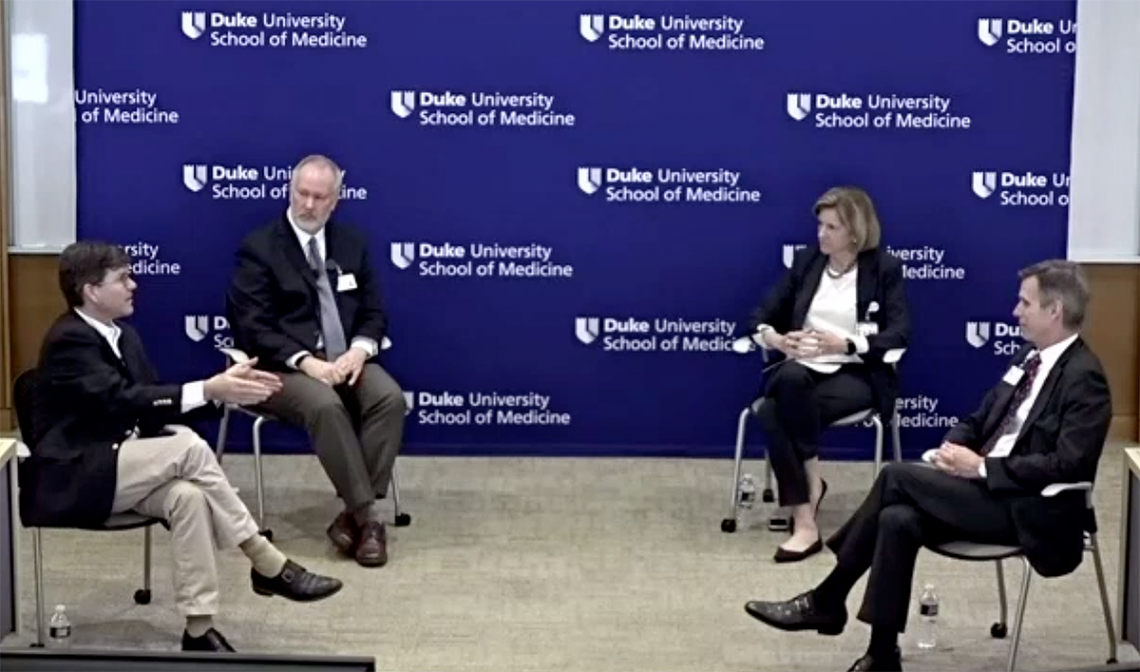
School of Medicine Dean Mary Klotman hosted a virtual town hall Tuesday with three school experts on how Duke is well positioned to advance understanding of the virus and lead efforts toward a potential vaccine.
Below are highlights from the virtual town hall. Comments have been lightly edited for clarity.
Who is considered high risk for COVID-19?
Joe Rogers: “There seems to be a real increase in severity of illness and risk for mortality as age increases. The people who seem to be particularly vulnerable are those who are older than 80 years of age. [Early reports indicate] that individuals who have heart disease, lung disease—diabetes has come out in a couple of risk models—and those who are immunosuppressed (organ transplant patients, people who take immunosuppressive medicines or have an intrinsic disease that makes their immune system less robust) seem to also be at high risk.”
What’s coming in terms of therapeutics?
Chris Woods: “We don’t have specific therapies for this virus … but there are a lot of exciting things moving forward. One particular drug by Gilead called remdesivir [that was originally developed for Ebola] is a broadly active antiviral; it has been used in at least one clinical trial in China, the results of which people are very much anticipating. It’s also a key drug in one trial that NIH has initiated to assess the performance of that drug in a randomized fashion.”
Why does it take 12-18 months to develop a vaccine?
Chris Woods: “The process to [develop] a modern vaccine is very complex. There is a series of studies that must be done to ensure the safe implementation: There’s a pre-clinical phase, where animal studies are done; then there is a first-in-human phase [Phase I], where we assess the safety; and then you start moving into phases where you assess the ability of the vaccine to actually prevent disease. That is done best when you have ongoing disease transmission.”
Mary Klotman: “Phase I safety is so important. The safety cannot be skipped, particularly for a vaccine that might go into millions.”
“One of the major potential impacts that academic health systems can have is the ability to mobilize to get things studied very fast. I am so proud of our faculty that have heard the call to arms and have done an amazing job mobilizing to get our research re-focused on this issue.”
-- Dr. Mary Klotman
How is Duke well positioned to advance the quest for a vaccine?
Mary Klotman: “The Duke Human Vaccine Institute has focused for many years on HIV. But over the years we’ve developed a lot of tools, a lot of technology, and a lot of understanding of the science of delivery of vaccines to be able to apply that to a number of pathogens.”
Colin Duckett: “The vaccine work that the Duke Human Vaccine Institute has been doing has taken a two-pronged approach. First, the approach of looking at the virus itself, and developing parts of the virus that can be introduced as a traditional vaccine, to give you the standard type of vaccination that is tried and tested. And then there are the remarkable experimental vaccines that hold so much promise, where you can bypass those steps and develop a vaccine much more quickly. … We couldn’t have done that work without the infrastructure that we’ve created over the last 20 years in the Duke Human Vaccine Institute.”
How is the Duke University Health System preparing?
Mary Klotman: “In our health system, we’re not only thinking about how to minimize the opportunity for infections to be transmitted within our environment—but we’re also making sure we are scaling up and are ready to take care of the vulnerable patients who are at risk for major complications.”
Joe Rogers: “We began by limiting patient and visitor access. We’ve ramped up our testing capabilities, and just in the last day we’ve opened up some drive-by screening clinics that will be by appointment only for the time being, and we will be using our telemedicine platform to screen those patients to determine who should use those.
“With our inpatient facilities, we’ve done things to ensure that our intensive care units are prepared to manage this patient population. We’ve also spent a significant amount of time with our staff and our physicians, preparing them for what this potentially could look like and making sure that they will be safe in a healthcare environment.”
Advice for the community?
Joe Rogers: “The last piece that the health system has focused on is being a source of truth. What we know about the virus is that about 80 percent of people who contract this virus have a flulike illness and will recover—so the people we need to concentrate on are the 20 percent who have the potential to get quite ill.”
Mary Klotman: “Anybody can be a vector for this illness. Pay attention to what your local communities and leaders are telling you, and practice social distancing, even if you’re young and healthy and have no other disease. This is a very important public health intervention.”
PANELISTS
- Mary Klotman, dean of the Duke University School of Medicine and vice chancellor for health affairs at Duke University
- Chris Woods, professor, medicine and global health; co-director, Hubert-Yeargan Center for Global Health; and chief, Infectious Diseases Division, Durham VA Medical Center
- Colin S. Duckett, vice dean for basic science and research professor of pharmacology and cancer biology
- Joseph G. Rogers, professor of medicine and chief medical officer for Duke University Health System